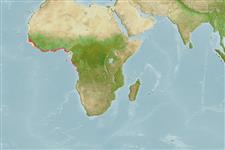>
Clupeiformes (Herrings) >
Dorosomatidae (Gizzard shads and sardinellas)
Etymology: Ethmalosa: Greek, ethmos, -ou = sieve, also the ethmoides bone + Latin, alausa = a fish cited by Ausonius and Latin, halec = pickle, dealing with the Greek word hals = salt; it is also the old Saxon name for shad = "alli" ; 1591 (Ref. 45335).
Environment: milieu / climate zone / depth range / distribution range
นิเวศวิทยา
เกี่ยวกับทะเล,น้ำเค็ม; น้ำจืด; กร่อย; ปลาที่อพยพจากแหล่งน้ำจืดไปวางไข่ในน้ำเค็ม (Ref. 51243); ระดับความลึก 0 - ? m (Ref. 54436), usually 0 - 50 m (Ref. 54436). Tropical; 25°N - 8°S, 17°W - 14°E (Ref. 54436)
Atlantic Ocean: Eastern central Atlantic Ocean, from Dakhla in Western Sahara southward to Lobito Bay in Angola (Ref. 188, 5286, 81269, 81631), occasionally entering freshwater (Ref. 3509). Reports from Cape Verde Islands are based on an erroneous type locality for Clupea fimbriata by Bowdich (1825), which was later rectified as probably Gambia (Ref. 188, 5286, 94080).
Length at first maturity / ขนาด / น้ำหนัก / Age
Maturity: Lm 17.0 range ? - 18.5 cm
Max length : 46.0 cm TL เพศผู้/กระเทย; (Ref. 1989); common length : 25.0 cm TL เพศผู้/กระเทย; (Ref. 187); น้ำหนักสูงสุดที่มีการรายงาน: 1.0 kg (Ref. 1989)
เงี่ยงครีบหลัง (รวม): 0; ก้านครีบอ่อนที่หาง (รวม): 16-19; เงี่ยงครีบก้น 0; ก้านครีบอ่อนที่ก้น: 19 - 25; สัตว์มีกระดูกสันหลัง: 40 - 44. Diagnosis: Body fairly deep, compressed, scutes present along belly; upper jaw with distinct notch, into which tip of lower jaw fits; lower gillrakers long, fine and numerous, about 3 times as long as gill filaments, upper gillrakers bent sharply upward, V-shaped; pelvic fin rays with 1 unbranched and 7 branched rays; caudal fin tips long and pointed (Ref. 188). A faint dark spot behind gill cover, sometimes followed by others; dorsal fin tip black; caudal fin deep chrome yellow; golden tints on body (Ref. 188, 81269). Ethmalosa fimbriata resembles Sardinella aurita, Sardinella rouxi and especially Sardinella maderensis, but these are more slender, have a rounded upper jaw which is not notched and the upper gillrakers are not bent upward like an elbow (Ref. 188).
Ethmalosa fimbriata is found in fairly shallow coastal waters, lagoons and estuaries, and sometimes also in lower courses of coastal rivers, even more than 300 km up rivers (Ref. 187, 188, 81269, 81631). It feeds principally on phytoplankton, chiefly diatoms, filtered by the very fine gillraker sieve (Ref. 187, 188, 3166). It breeds throughout the year in waters of salinities 3.5-38 ppt, but with peaks in at least some areas; spawns in the sea, in estuaries and in rivers (Ref. 188). The largest fisheries are in Senegal, Sierra Leone, Ivory Coast, Nigeria and Cameroon, mainly in the dry season (Ref. 188).
Breeds all year in waters of salinities 3.5 to 38 ppt, but with peaks in at least some areas, becoming progressively later to south. Spawns in the sea, in estuaries and in rivers.
Whitehead, P.J.P., 1985. FAO Species Catalogue. Vol. 7. Clupeoid fishes of the world (suborder Clupeoidei). An annotated and illustrated catalogue of the herrings, sardines, pilchards, sprats, shads, anchovies and wolf-herrings. FAO Fish. Synop. 125(7/1):1-303. Rome: FAO. (Ref. 188)
IUCN Red List Status (Ref. 130435)
Threat to humans
Harmless
Human uses
การประมง: เน้นการพาณิชย์; การเพาะเลี้ยงสัตว์น้ำ: การทดลอง
ข้อมูลเพิ่มเติม
อ้างอิงการเพาะเลี้ยงสัตว์น้ำประวัติการเพาะเลี้ยงสัตว์น้ำสายพันธุ์พันธุศาสตร์ElectrophoresesอัตราพันธุกรรมโรคการแปรรูปNutrientsMass conversion
ผู้ร่วมมือรูปภาพหลายรูปStamps, Coins Misc.เสียงปลามีพิษ เช่น ปลาปักเป้าความเร็วรูปแบบการว่ายน้ำพื้นที่เหงือกOtolithsสมองวิสัยทัศน์
เครื่องมือ
Special reports
Download XML
แหล่งที่มาจากอินเตอร์เน็ต
Estimates based on models
Preferred temperature (Ref.
123201): 20.2 - 27.9, mean 26.4 °C (based on 180 cells).
Phylogenetic diversity index (Ref.
82804): PD
50 = 1.0000 [Uniqueness, from 0.5 = low to 2.0 = high].
Bayesian length-weight: a=0.00933 (0.00806 - 0.01080), b=3.05 (3.01 - 3.09), in cm total length, based on LWR estimates for this species (Ref.
93245).
ระดับชั้นอาหาร (Ref.
69278): 2.5 ±0.20 se; based on food items.
ความสามารถในการกลับคืนสู่ปกติ (Ref.
120179): ความสูง, เวลาต่ำสุดที่จะทำให้ประชากรเพิ่มขึ้นเป็น 2 เท่าใช้เวลาน้อยกว่า 15 เดือน (K=0.25-0.36; tm=1; Fec=16,000).
Prior r = 0.93, 95% CL = 0.61 - 1.39, Based on 5 stock assessments.
Fishing Vulnerability (Ref.
59153): Low vulnerability (21 of 100).
Climate Vulnerability (Ref.
125649): High vulnerability (60 of 100).
Nutrients (Ref.
124155): Calcium = 181 [96, 321] mg/100g; Iron = 1.91 [1.04, 3.19] mg/100g; Protein = 19 [17, 21] %; Omega3 = 0.374 [0.211, 0.670] g/100g; Selenium = 65.7 [32.1, 137.4] μg/100g; VitaminA = 8.42 [3.24, 21.22] μg/100g; Zinc = 1.75 [1.23, 2.59] mg/100g (wet weight); based on
nutrient studies.
